Important Questions: Production & Costs | Economics Class 11 - Commerce PDF Download
Very Short Answer Type Questions
Q1: What will be the MP when TP is maximum?
Ans: Marginal Product will be zero when Total Product is maximum.
Q2: TPP increases only when MPP increases.
Ans: False, TPP also increases when MPP decreases but remains positive.
Q3: When there are diminishing returns to a factor marginal and total products always fall.
Ans: False, only MPP falls, not TPP. In case of diminishing returns to a factor TPP increase at diminishing rate.
Q4: Why AFC curve never touches “x‟ axis though lies very close to x axis?
Ans: Because TFC can never be zero.
Q5: What is meant by production?
Ans: Production means transformation of input into output through specific process.
Q6: When there are diminishing returns to a factor, total product always decreases.
Ans: False, as TPP increases at a decreasing rate when there is diminishing returns to a factor.
Q7: Increase in TPP always indicates that there are increasing returns to a factor.
Ans: False, TPP increases even when there are diminishing returns to a factor.
Q8: Why AVC and AFC always lie below AC?
Ans: AC is the summation of AVC & AFC so AC always lies above AVC & AFC.
Q9: When TVC is zero at zero level of output, what happens to TFC or Why TFC is not zero at zero level of output?
Ans: Fixed cost are to be incurred even at zero level of output.
Short Answer Type Questions
Q10: What is change in quantity demanded?
Ans: It is also called movement along a demand curve. Due to change in its own price, quantity of commodity changes.
There are two type of change in quantity of Demand
- Extension in Demand
- Contraction in Demand
Q11: Define cost concept. What are the different types of costs?
Ans: Cost is a fundamental economic concept that refers to the value of resources used or sacrificed to achieve a specific objective, such as producing a good or providing a service. Costs can be incurred by individuals, businesses, or governments, and they play a crucial role in decision-making processes, especially in the field of economics and business.
There are several types of costs, each serving a different purpose in analyzing the overall cost structure of a business or a project. Here are the main types of costs:
- Fixed Costs (FC): Fixed costs are expenses that do not change regardless of the level of production or output. These costs remain constant within a certain range of production or time. Examples include rent, salaries of permanent staff, and insurance premiums.
- Variable Costs (VC): Variable costs fluctuate in direct proportion to the level of production or output. As production increases, variable costs increase; conversely, they decrease when production decreases. Examples include raw materials, direct labor for manufacturing, and utilities directly tied to production.
- Total Costs (TC): Total costs are the sum of fixed costs and variable costs. It represents the overall cost incurred by a business in its operations.
- Marginal Costs (MC): Marginal cost is the additional cost incurred by producing one more unit of a good or service. It is calculated by dividing the change in total cost resulting from producing one additional unit by that unit's quantity.
- Average Costs: Average Fixed Cost (AFC): AFC is calculated by dividing total fixed costs by the quantity of output. It decreases as production increases due to the fixed costs being spread over a larger number of units.
- Average Variable Cost (AVC): AVC is calculated by dividing total variable costs by the quantity of output. It generally decreases initially with increased production due to economies of scale but may increase at higher levels of production.
- Average Total Cost (ATC or AC): ATC is calculated by dividing total costs (fixed costs + variable costs) by the quantity of output. It reflects the average cost per unit of output and is the sum of AFC and AVC.
- Explicit Costs: Explicit costs are direct, out-of-pocket expenses paid by a firm in conducting its business activities. These costs involve tangible payments for resources such as wages, rent, and utilities.
- Implicit Costs: Implicit costs, also known as opportunity costs, represent the value of resources used in a firm's operations for which no direct payment is made. It includes the value of owner's time, resources diverted from other opportunities, and the return on self-owned resources.
- Sunk Costs: Sunk costs are costs that have been incurred and cannot be recovered. They should not affect future decision-making processes because the money spent on them cannot be regained.
- Economic Costs: Economic costs include both explicit and implicit costs. It measures the total opportunity cost of utilizing resources to produce a specific output, taking into account the potential earnings from the best forgone alternative.
Q12: What are Returns to a Factor? What do you mean by the Law of Diminishing Returns?
Ans: Returns to a Factor is used to explain the behaviour of physical output as only one factor is allowed to vary and all other factors are kept constant. This is a short-run concept. The law of diminishing returns to a factor states that as the variable factor is allowed to vary (increase), keeping all other factors constant, and the Marginal Product first increases, reaches it is the maximum and then declines and even becomes negative.
Q13: What is change in demand?
Ans: Change in Demand: - It is also called shift in demand curve. When quantity of commodity change due to change in factor other than price. It has two types
(a) Increase in Demand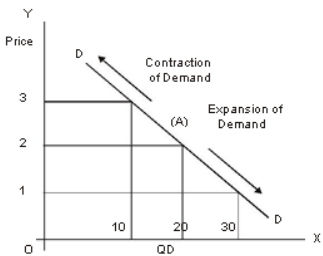 (b) Decrease in Demand
(b) Decrease in Demand
Q14: Explain the relation between AC and MC with the help of a diagram.
Ans: The relation between AC and MC is explained with the help of a diagram as under: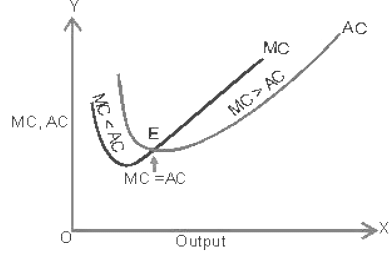
Observations:
- When AC declines, MC declines faster than AC. So that MC curve remains below AC curve. Implying that AC > MC. In the figure, AC curve is falling till point E and MC continues to be lower than AC.
- When AC increases, MC increases faster than AC. So that MC curve is above the AC curve. Implying that AC < MC. In the figure, AC start rising from point E and beyond E, MC is higher than AC.
- MC curve cuts AC curve from its lowest point. When average curve is minimum then MC = AC. In the figure, MC curve is intersecting AC curve at its lowest or minimum point E.
Long Answer Type Questions
Q15: Explain the determinants of supply?
Ans: Supply is the quantity of a good that is offered for sale at a given price at a particular time. Supply is a desired flow. It measures how much firms are willing to sell and not how much they actually sell. Supply may exceed or fall short of production. Supply in a particular year is the total production plus stocks of the commodity.
Supply function can be expressed as
Sx = f (Px, Pa… Pc, PL… PO, T, Cr, St, O, G)
Where Px → own price of good x, Pa … Pc → prices of related goods, PL … PO→ prices of inputs, T → time, St → the state of technology, O → objectives of the firm, and G → taxes, subsidies and regulation.
Determinants of supply can be understood from the diagram below: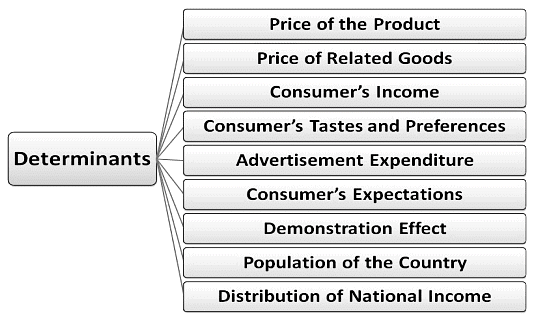
Some of the determinants are explained here:
- Production cost: Since most private companies’ goal is profit maximization. Higher production cost will lower profit, thus hinder supply. Factors affecting production cost are: input prices, wage rate, government regulation and taxes, etc.
- Technology: Technological improvements help reduce production cost and increase profit, thus stimulate higher supply.
- Number of sellers: More sellers in the market increase the market supply.
- Expectation for future prices: If producers expect future price to be higher, they will try to hold on to their inventories and offer the products to the buyers in the future, and thus they can capture the higher price.
Q16: Explain the relation between Marginal Cost and Average Variable Cost with the help of diagram.
Ans: Relationship holding between marginal cost and average variable cost is also one of the many cost relationships. When marginal cost is less than average variable cost, average variable cost is decreasing. On the contrary, when marginal cost is greater than average variable cost, average variable cost is increasing. In some cases, this also means that average variable cost takes on a U-shape, though this is not guaranteed since neither average variable cost nor marginal cost contain a fixed cost component. In business, both the fixed and variable costs are used to determine the cost of production. Marginal costs measure the change in production expenses for making each additional item. Variable costs reflect the materials necessary to manufacture or make each product. As a result, the variable costs directly impact the marginal cost.
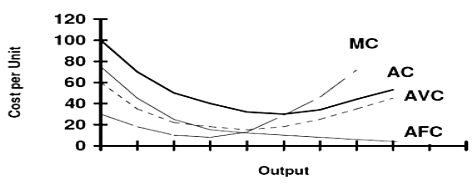
Let’s take an example, Mary own a bakery and she is considering adding other options to her existing menu along with cakes. Other new stuffs will be sandwiches. But she will need to look at both the variable and marginal costs to determine if it's worth it. She should calculate the average cost of the extra ingredients and labour necessary to make the sandwiches. Then, she will need to use the variable costs and fixed costs to calculate the marginal cost. If the marginal cost associated with a sandwich is too high to bring in profit, the she wouldn't want to bother adding it.
Q17: State the behaviour of Marginal product is the Law of Variable Proportions. Explain the causes of this behaviour.
Ans: Law of variable proportion states that the marginal product of the factorinput, initially rises with the employment level. But soon it starts falling once it reaches to a certain level of employment. This law can be well understood from the below diagram:
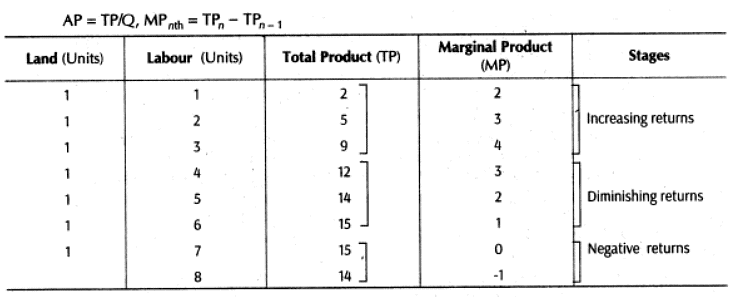
From the above diagram and table, we can jot down observation below:
(i) MP rises till 3rd unit of labour are employed, in this condition TP increases at increasing rate, this condition is called condition of increasing returns.
(ii) With the use of 4th unit of labour, MP starts decreasing and TP increases only at decreasing rate, this condition is called condition of diminishing returns.
(iii) When decreasing MP reduces to zero, Total Product is maximum.
(iv) When marginal product is negative, total products starts declining Law of variable proportion basically depends on diminishing returns to marginal factor and the causes are imperfect factor sustainability, poor coordination between the factors, etc.
|
59 videos|222 docs|43 tests
|
















